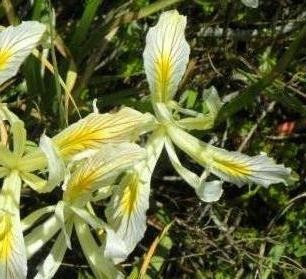Siskiyou iris
(Iris bracteata)

Description
Iris bracteata, with common name is Siskiyou iris, is a species of iris. It is endemic to the Klamath Mountains, in Del Norte County, California, and Curry County, Josephine County, and Jackson County, Oregon, in the United States. Its flowers grow singly or paired on a stem, and are usually cream-colored or yellowish with purple or brown veining. Iris is a genus of 260–300 species of flowering plants with showy flowers. It takes its name from the Greek word for a rainbow, which is also the name for the Greek goddess of the rainbow, Iris. Some authors state that the name refers to the wide variety of flower colors found among the many species. As well as being the scientific name, iris is also widely used as a common name for all Iris species, as well as some belonging to other closely related genera. A common name for some species is 'flags', while the plants of the subgenus Scorpiris are widely known as 'junos', particularly in horticulture. It is a popular garden flower. The often-segregated, monotypic genera Belamcanda (blackberry lily, I. domestica), Hermodactylus (snake's head iris, I. tuberosa), and Pardanthopsis (vesper iris, I. dichotoma) are currently included in Iris. Three Iris varieties are used in the Iris flower data set outlined by Ronald Fisher in his 1936 paper The use of multiple measurements in taxonomic problems as an example of linear discriminant analysis. Irises are perennial plants, growing from creeping rhizomes (rhizomatous irises) or, in drier climates, from bulbs (bulbous irises). They have long, erect flowering stems which may be simple or branched, solid or hollow, and flattened or have a circular cross-section. The rhizomatous species usually have 3–10 basal sword-shaped leaves growing in dense clumps. The bulbous species have cylindrical, basal leaves. The inflorescences are in the shape of a fan and contain one or more symmetrical six-lobed flowers. These grow on a pedicel or peduncle. The three sepals, which are usually spreading or droop downwards, are referred to as "falls". They expand from their narrow base (the "claw" or "haft"), into a broader expanded portion ("limb" or "blade") and can be adorned with veining, lines or dots. In the centre of the blade, some of the rhizomatous irises have a "beard" (a tuft of short upright extensions growing in its midline), which are the plant's filaments. The three, sometimes reduced, petals stand upright, partly behind the sepal bases. They are called "standards".
Taxonomic tree:







